The Path to the Corner Office

Do some roles and experiences prepare you for the CEO role better than others? We looked at the data and talked to a few Texas CEOs to find out.
There are as many paths to the CEO role as there are individual CEOs.
Nevertheless, we can see certain patterns regarding who attains the CEO role and how they perform once they get there. For example, we know that most CEOs at large companies are promoted internally. Among S&P 500 companies in 2020, 77 percent of new CEOs were promoted from within, often as a result of extensive succession planning.1 We also know that during COVID-disrupted 2020, those insider CEOs tended to slightly outperform their peers appointed from outside the company.2
In this article, we want to look at a specific facet of the journey to the CEO role: namely, the functional background and expertise of people who land in the CEO chair, and how that background influences them once they get there.
Who’s Being Hired as CEO in the S&P 500?
A recent study by executive search firm Spencer Stuart shed new light on the common paths future CEOs take to the corner office. Researchers examined every new CEO appointed in the S&P 500 since 2000. They found that, currently, two types of leaders are neck-and-neck when it comes to being hired as new CEOs: chief operating officers (who make up 38 percent of new S&P 500 CEOs) and division heads (who make up 36 percent).3
This represents a significant shift. Two decades ago, COOs accounted for the vast majority of new CEO appointments—around 76 percent. Write the authors of the Spencer Stuart report:
The COO role was popularized in the 1990s as companies embraced management trends such as total quality management, kaizen, etc. COOs, who gained experience overseeing complex operations and knowledge of all aspects of an organization, were viewed then as logical CEO successors. Since then, the share of COOs being promoted to CEO has consistently declined.
Today, boards still value operational expertise, but they have also learned to consider a more diverse pool of CEO candidates, with particular interest in those with experience managing complex, multifunctional groups. Thus the rise in appointments of division heads. Because a division head is like a mini-CEO—often overseeing their own product or line of business, having to understand the market, and coordinating multiple groups beneath them—they are today seen as especially well prepared for the CEO role.
Other studies of CEO career histories find a similar inclination toward operations. Kimberly Whitler, an assistant professor at the University of Virginia’s Darden School of Business, found that operations was the most common training ground for Fortune 100 CEOs, with 25 percent coming from an operational background. This was followed by finance (22 percent), engineering (17 percent), sales and marketing (13 percent), accounting (11 percent) and law (7 percent). Whitler also notes that “in many cases, the early-career function chosen by the F100 CEOs is also the dominant function of the firm that they helm.”4
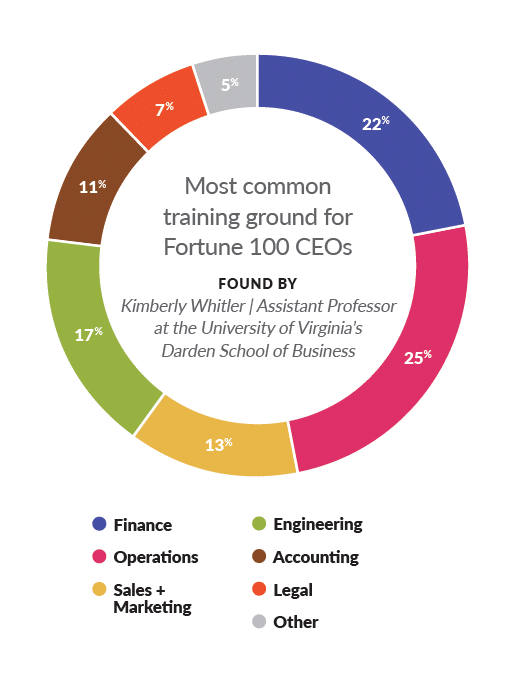
Heidrick & Struggles, which takes a global view of CEO succession in its annual Route to the Top report, shows that the tendency toward operationally oriented CEOs at enterprise companies is worldwide. Heidrick’s latest report looked at the most common previous C-suite experience of over 1,000 CEOs of the largest publicly listed companies across 24 markets. After those who had previously held a different CEO role, COO was most common, followed by CFO (see Fig. 2).5
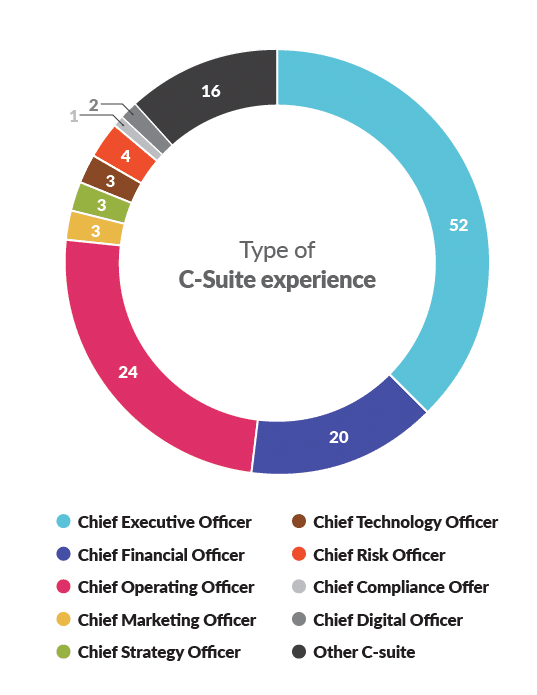
What About Other CEOs?
What about CEOs who aren’t leading large-cap companies? We have much less data on that sprawling group, which includes everyone from chief executives of highly successful midsize firms to the guy who just incorporated his business and changed his LinkedIn title to “CEO.”
To learn more, we conducted the Path to the Corner Office survey. This informal poll of a few Texas CEOs asked about their backgrounds and current views on the CEO role. Within this group of respondents, who primarily lead smaller organizations, the most common functional background was—that’s right—operations, followed by marketing (see Fig. 3). A slight majority of respondents were founders of their own companies, which is no surprise given the size of the represented companies.
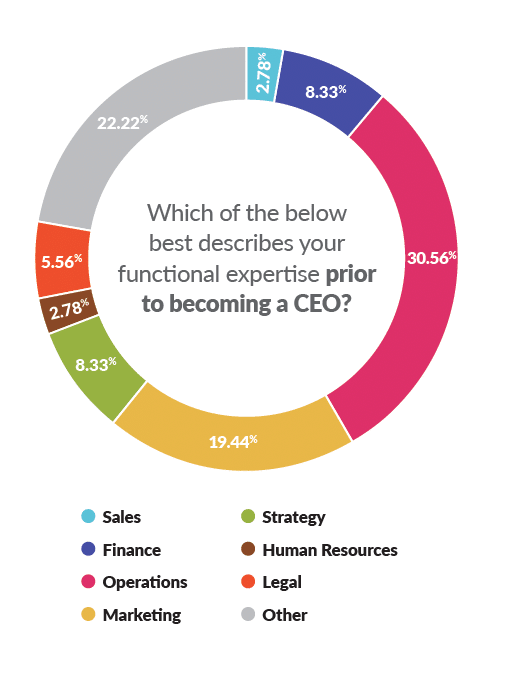
We also spoke to some of the respondents about their career experiences. We wanted to know: How did your pre-CEO experiences prepare you, or fail to prepare you, for the role? What strengths and blind spots did you have upon assuming the title of CEO? And how did you handle the transition from expert executive to leader of the entire organization?
Mark McClain, CEO, SailPoint Technologies
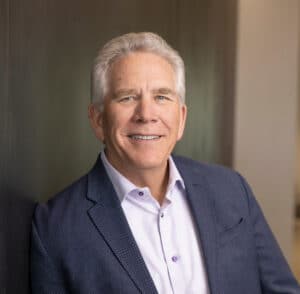
Pre-CEO functional focus: Marketing / Product Management
Mark McClain is the founding CEO of SailPoint, a provider of identity security for modern enterprise. He began his career in technical sales at IBM, then later got an MBA (a degree held by over 30 percent of North American CEOs6) with the intention of moving into marketing, which he did at Hewlett-Packard.
It was when McClain jumped ship from HP to Austin startup Tivoli that McClain got his first truly holistic view of an organization. Going from hundreds of thousands of employees at IBM and HP to Tivoli’s scrappy 200-strong workforce “was the first time I could see and touch all parts of the business,” says McClain, who served as Tivoli’s vice president of worldwide marketing. “I went, Oh, this is kind of cool. In big companies, you’re a little cog in the wheel unless you move way up the chain. I had already figured out that was not a path I was interested in.”
McClain found that one particular aspect of his work during these years prepared him uniquely well for being a CEO: product marketing and product management. “The product management function, at least the way it’s performed in good tech companies, is a really good CEO prep job,” says McClain. “It’s a bridge between the market need and what can be built in engineering. You have to understand markets, competitive dynamics, how engineers build things, and how salespeople will sell what gets built. Sometimes you get into the financials, too: Is this a valuable product? What’s it going to cost to build it? Can we sell it when we’re done?” McClain says that this experience isn’t something he would’ve had he remained in outbound marketing or sales.
The product-manager-to-CEO pipeline isn’t uncommon. Susan Wojcicki, CEO of YouTube, was the first product manager for Google’s AdSense, and later became Google’s Vice President of Product Management. Current Google CEO Sundar Pichai joined the company in a product management role. Steward Butterfield, cofounder and CEO of Slack, spent several years as Senior Director of Product Management at Yahoo.
Product management requires a person to become something of a generalist, with a baseline of proficiency in many different areas, which makes it good practice for aspiring CEOs. “If you’re not comfortable being a generalist, you really shouldn’t do the CEO job,” says McClain. “I like to say I’m an inch deep and a mile wide. I know a little bit about everything and not very much about anything. You have to be comfortable with that mindset.”
We also asked McClain whether his background in marketing and product management leads him to be disproportionately involved in those areas of SailPoint today. He says he’s much more used to being a company-wide leader after 20 years of doing it, so his approach is fairly balanced, without undue interference in marketing. But McClain does see this happen. “I always compare a founder or CEO’s background to a dad coaching his kid. You see both extremes. There’s the dad who’s way too hard on the kid, vicariously living through them. And then there’s the dad who’s so concerned about doing that that he hardly pays attention to his kid.
“You want to avoid both extremes,” says McClain. “If you’ve come from a function, pay attention, because you have some value to add probably, but do not grab the wheel and try to drive it. If you do, you’re going to drive away anyone competent from that leadership role. Why don’t you just do it yourself? they will think. Apparently you want to!”
Robert Nitsche, CEO, The Nitsche Group
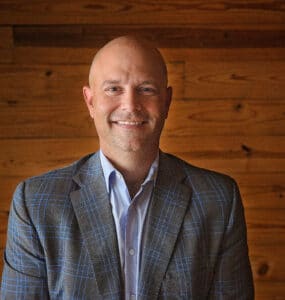
Pre-CEO functional focus: Finance
Robert Nitsche’s path to the corner office was different from most: He grew up in a family business that he now leads. The Nitsche Group, an independent insurance agency based in Giddings, Texas, with 10 offices across the state, was founded in 1949. Over the decades, it has gone by several names, including the Insurance Network of Texas, but the current name reflects the family that has long dominated its leadership, including Robert’s father, RJ, who came on board in 1971.
Robert Nitsche started at the bottom, as a kid. “My first job was coming in after school to vacuum and take out trash as my parents finished any other work that needed to get done,” he says. “I’m confident that my performance would have gotten me on a performance improvement plan—if that would have applied to me.”
Later, Nitsche got his first insurance-related job outside the family business, running IT for a small agency. After earning an MBA from Southern Methodist University, he took a position at a surety company, where he helped with financial reviews. “My time there really helped me see how you can use financial statements to find out what goes on in a business,” he says.
When he moved back to Austin in 1995 to work for the Nitsche Group, Nitsche ran the two departments he knew best: accounting and IT. Then, like many future CEOs, his management responsibilities began expanding to cover more and more departments. In 2010, he officially took over as CEO.
Asked what strengths his foundation in finance gave him as he took on the CEO role, Nitsche says, “Finance gives me a way to measure opportunities and ideas that I don’t have any other way to measure. When we have a new opportunity, we can start by looking at the financial measures to decide if it’s a good decision to pursue. During my time working for the surety company, we would see companies that would make big financial moves, then in later statements, see if it was a good move or not financially. That taught me to use my experience in finance to decide when to end or continue with a new project. That mindset and skill have become part of my strengths that I use quite often. While all business skills are important, financial skills can make or break a company in a way few others can.”
Nitsche encourages new CEOs who may be struggling with the financial domain of the business (which is many of them—see “Texas CEOs Answer: What Skills Did You Lack When You First Became CEO?”) to bring someone who does have that skillset onto the executive team, then learn financial and analytical skills from working closely with them.
We asked Nitsche whether he, with his finance-dominated careers, noticed any skills gaps in himself once he became CEO. “One of the blind spots is the human element in decision making,” says Nitsche. “A project won’t be truly successful—regardless of the financial success—if you forget the people who are there to make it happen. They are one of the biggest variables in any business decision.”
Nitsche has worked hard to develop his “people” abilities as chief executive. “A CEO’s role isn’t always just about making the right financial decision,” he says. “It’s about leading the people involved to believe in that decision. Learning to pair your financial decision-making with good communication will help you in your role as CEO.”
Although CFOs are often the de facto #2 to the CEO, it is relatively uncommon for a financial officer to be promoted directly to CEO within the same organization. Increasingly, boards want to see a financial professional who also has experience with other aspects of business—including leading people effectively and not just preparing a P&L but being responsible for it.
In a study of CFO to CEO transitions, Korn Ferry recommends that CFOs expand their social leadership skills to effectively position themselves for the CEO role, echoing Nitsche’s observations above. Korn Ferry CEO Gary Burnison notes that broader experience helps: “One of the reasons you move a CFO to a line position is not only to get that experience with customers, but to develop the right-brain skills that are needed to manage people.”
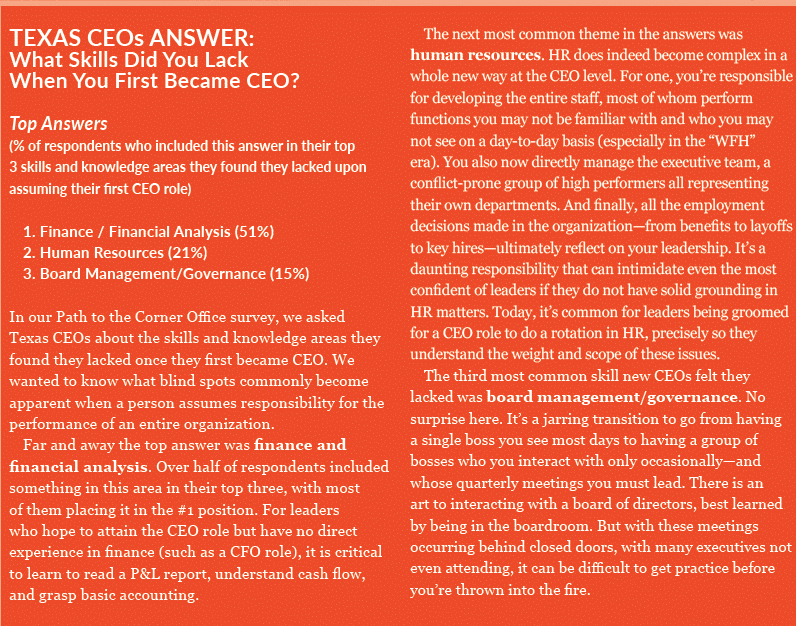
Barbara A. F. Greene, CEO, Greene and Associates, Inc.

Pre-CEO functional focus: Human Resources
Long before the term “Great Resignation” was on everyone’s tongues, smart companies understood the deeply human side of organizational success. Unless a company can attract, engage, and develop highly talented people, it is destined to fail eventually, no matter how brilliant its product or promising its market. This is partly why leaders with a background in HR can bring a lot to the CEO role—though this track is relatively rare.
Barbara A. F. Greene is the founder and CEO of San Antonio–based Greene and Associates, Inc., a talent management and career coaching organization and a partner in Career Partners International. Greene began as an educator, then moved into higher education leadership before transitioning to HR in Corporate America. She became CEO when she decided to start her own HR consulting company, Greene and Associates, which celebrated 25 years in business last year. Today, her firm’s clients include Fortune 50 companies and Greene serves as a trusted advisor to CEOs and chief human resource officers.
We asked Greene how her expertise in HR influences her leadership as CEO and her work with CEO clients. She says that it was ingrained in her from her early career—all the way back to the classroom—that every human being she works with can be better. No matter where someone is starting from, there is potential to develop and grow.
Greene also notes that HR leaders have often developed the ability to engage and build strong, trusting relationships with people, including those from all different types of backgrounds. In a time when nearly all companies must win in the people business, this skill set is highly desirable in a CEO, particularly when paired with financial acumen and an understanding of the market.
In the enterprise context, directors have not historically seen CHROs as a natural choice for the CEO job. That has changed, slowly, over the past several years, as an increasing number of CHROs are treated as strategic partners in the business—given the proverbial “seat at the table”—rather than as leaders of an administrative backwater.
There is evidence both objective and anecdotal that many HR leaders do have what it takes to be CEO. Several years ago, Ellie Filler, senior client partner at executive-search firm Korn Ferry, worked with Dave Ulrich, a professor at the University of Michigan, to examine the leadership styles of various high-performing C-suite executives: CEO, COO, CFO, CMO, CIO, and CHRO. Looking at a decades’ worth of Korn Ferry assessments administered to C-suite candidates, they scored each professional in 14 areas, grouped into three larger categories: leadership style, thinking style, and emotional competency.
Which type of C-suite professional would you guess has traits most similar to the CEO? COO is the correct answer—reflecting again that operational leaders are often natural choices for chief executive. But close on the COO’s heels is the CHRO, who often looks very similar to the CEO in their leadership, thinking, and emotional competency. Filler and Ulrich concluded that CHROs offer an overlooked source of potential CEO talent—but warn that HR leaders who do aspire to the CEO role must also demonstrate general management ability and have P&L experience.7
Though HR remains a relatively uncommon CEO career track, there are several examples of high-profile HR leaders taking the helm of large companies. Nigel Travis, who led Dunkin’ Brands and Papa John’s International as CEO, began his career with over 20 years in HR leadership (though he earned a COO role at Blockbuster before his first CEO role). Mary Barra, CEO of General Motors, did a relatively brief stint running the company’s global HR department on her way to the corner office. And when Xerox was needed a people-oriented leader in 2001, they chose Anne Mulcahy, whose first senior position at the company was in HR.
Amy J. Jones, CEO, O’Connell Robertson

Pre-CEO functional focus: Marketing / Communications
When Amy Jones was getting a journalism degree at the University of Texas, she had no inkling that she would one day hold a CEO title. But that’s exactly where her career took her. From the start, Jones was passionate about communications, specifically communicating information in print. Her first job out of college was at a state association, where she learned that every organization requires communications expertise.
Jones’s next move was to the Austin Chamber of Commerce, where her role covered PR, communications, and marketing. From there, she was recruited to the company she would later lead as CEO: the architecture and engineering firm O’Connell Robertson. She came on as the firm’s first focused marketing director, about 25 years ago.
Like many future CEOs, Jones steadily grew her reach within the organization. During this period, she capitalized on her natural communications ability, whether it was public-facing communication or communication between the firm’s clients and its designers and engineers. Over time, her role expanded to leading O’Connell Robertson’s business development, marketing, communications, and community relations efforts. She became a principal of the firm in 2004, president in 2016, and president and CEO in 2020.
We asked Jones about the aspects of the CEO role she hadn’t anticipated. “What I am most surprised by is the amount of time I now spend communicating internally—after so many years of being an external face of the firm,” she says. As CEO, she has consistently leveraged her strengths in communications, being sure to connect with both groups of stakeholders. “Because of my background in marketing and communications, I’m a transparent and communicative CEO and firm leader. As CEO, you operate on different levels of communication all the time. You’re typically the one sharing corporate news and information in an ambassador or PR role for the firm. You must be able to speak with radical candor, showing you care personally, while challenging team members directly in your role as a leader. Finally, you must be able to have compassionate conversations, because at any given time you will have employees dealing with significant personal issues.”

Taking on the official CEO role in 2020, compassionate conversations were certainly necessary. During the pandemic, it became clear to Jones that the stress and isolation of COVID-19 could have a significant negative impact on the firm’s connectivity and culture. She worked with the leadership team to develop a corporate engagement program, which launched in June 2020. Its aim was to ensure strong communication, high participation, and a robust firm culture while everyone was working from home. The plan addressed staff support, mentoring, and culture through a variety of regular check-ins, conversations, and meetings.
“The whole program centered around communications,” says Jones. “I think that had I not been a communications professional first and foremost, we would have overlooked the need for something more structured, and we probably wouldn’t have been attentive enough to this issue.”
Jones says it is difficult to leave behind the day-to-day focus on marketing, communications, and where new business will come from after so many years of this being her primary domain. But she also recognizes the importance of staying engaged with all facets of the organization as she guides the vision for O’Connell Robertson’s 5-year growth strategy.
Her advice for marketing and communications leaders who aim for a CEO position down the road? “Volunteer to lead a special project or short-term task force,” Jones says. “Marketers should also take any opportunity to learn the business operations of the organization they are supporting, including financial circumstances. For me, it took participating in design meetings and client conversations with the architects and engineers, and listening to them discuss the services we provided, before I could bring a perspective to that part of the business that was recognized as leadership.”
• • •
Nearly all new CEOs find that the job demands something markedly different from the career they built before. It requires going from specialist to generalist, from “behind the scenes” to “in the spotlight,” from accountable to one boss to accountable to a whole host of stakeholders. The keys to CEO success are many, but one of the most fundamental is this: You must learn how to apply the skills that got you there even as you rapidly grow the new skills necessary to effectively lead the entire organization.
There is no perfect pedigree or career track for the CEO role. But if you understand the nature of the job and how it compares to the capabilities you have now, you’ll be better prepared to get there—regardless of your functional expertise.
1 Harvard Business Review, “Finding the Right CEO,” January–February 2022.
2 Md Reiazul Haque, Bobae Choi, Doowon Lee, and Sue Wright, “Insider vs. Outsider CEO and Firm Performance: Evidence from the Covid-19 Pandemic,” Finance Research Letters, December 3, 2021.
3 Spencer Stuart, The Last Mile to the Top: Future CEOs Who Beat the Odds, December 2021.
4 Kimberly A. Whitler, “New Study on CEOs: Is Marketing, Finance, Operations, or Engineering the Best Path to CEO?,” Forbes.com, October 12, 2019.
5 Heidrick & Struggles, Route to the Top 2021.
6 Nicole Torres, “MBAs Are More Self-Serving Than Other CEOs,” Harvard Business Review, December 2016.
7 James Kosur, “How Do CFOs Make the Jump into the CEO Role?,” World Economic Forum, October 12, 2015.
8 Ellie Filler, CEOs and CHROs: Crucial Allies and Potential Successors, Korn Ferry, December 2014.






